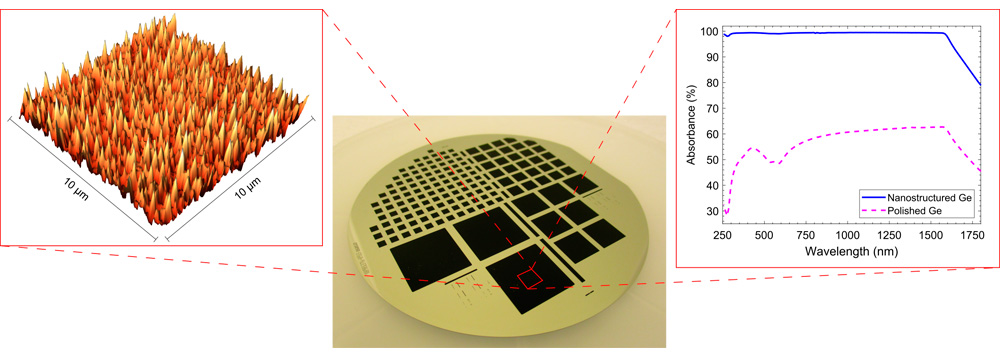© SUGER
What has the ATTRACT seed funding enabled you to do so far?
With the ATTRACT funding, we have a chance to study our novel ideas that aim to revolutionise the sensitivity of germanium-based radiation sensors. We have already developed a process to fabricate nanostructures on germanium substrates. The nanostructures eliminate reflectance entirely, and consequently, the absorbance of the nanostructured germanium wafers is >99 % in the whole UV-VIS-NIR spectrum up to 1600 nm wavelength. We have also found an efficient method to improve the electrical quality of germanium surfaces.
What challenges have you faced so far?
The first challenge that we faced was the non-homogeneity of the nanostructuring process. The developed recipe first produced black surface only on small areas close to the wafer edges. We needed to optimise the process gas flows and chamber pressure to find a repeatable process that produces uniform nanostructures throughout the whole 100-mm-diameter wafer. Another challenge is to get the sidewalls of the nanostructures smooth enough so that charge carrier recombination at the nanostructured surface can be efficiently reduced by atomic-layer-deposited thin films. The results indicate that this can likely be achieved by reducing the plasma power used in the process.
Where does your ATTRACT journey go from here?
The results that we have obtained so far on material level have been very promising, and hence, we have high potential to succeed in improving the efficiency of germanium-based sensors. We are currently fabricating proof-of-concept devices to demonstrate the new technologies, which we have developed within the project, in actual sensors.
Sum up in two sentences the advantages of the ATTRACT Programme over other research funding schemes.
The programme encourages to work on a high risk – high reward project, which increases the chances for new breakthroughs. The ATTRACT organisation takes care of the advertising of the projects and creates an environment that encourages the projects to collaborate.
For more information
Visit the SUGER project site


